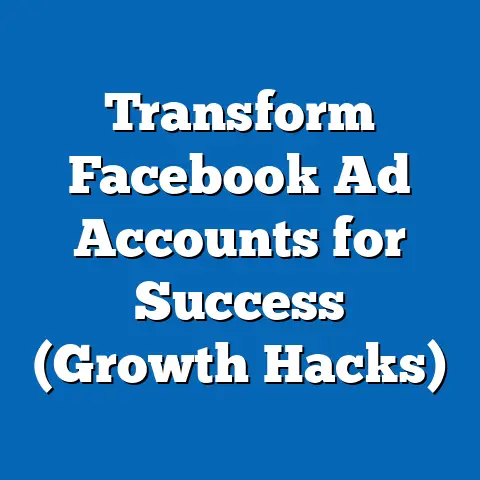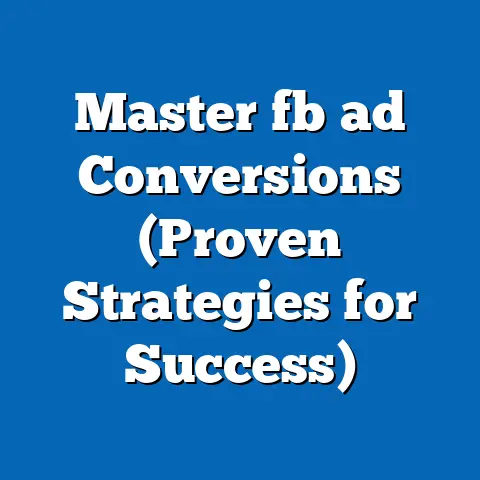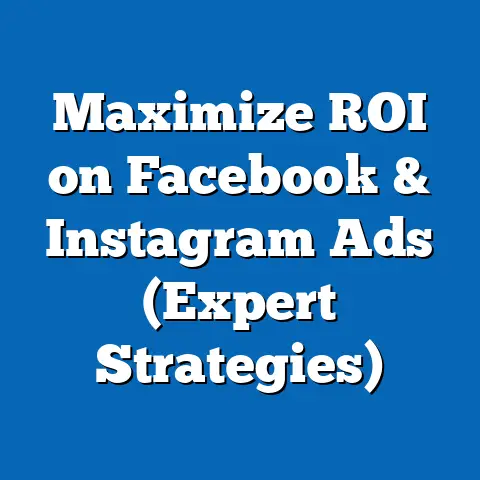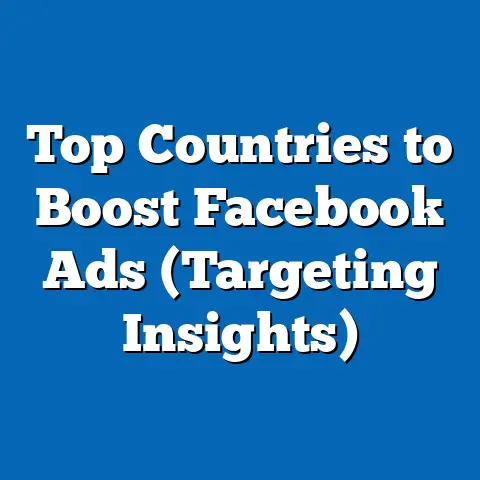Uncover Winning Keywords for Facebook Ads (Expert Tips)
In the ever-evolving world of digital marketing, the ability to craft effective Facebook ad campaigns has become a cornerstone for businesses, political campaigns, and advocacy groups aiming to reach targeted audiences. At the heart of these campaigns lies the strategic use of keywords—specific terms or phrases that resonate with particular demographics and trigger engagement. This article provides a comprehensive analysis of how to uncover winning keywords for Facebook ads, exploring the demographic makeup of key user groups, their core beliefs and behaviors, and the distinguishing characteristics that set them apart from other digital audiences. By grounding this analysis in data-driven insights and expert tips, we aim to equip marketers with actionable strategies to optimize their ad performance.
Part 1: Understanding the Facebook Audience Landscape
Demographic Composition of Facebook Users
Facebook, with over 2.9 billion monthly active users as of 2023 (Statista, 2023), remains one of the most diverse social media platforms globally, spanning multiple generations, income levels, and cultural backgrounds. In the United States, for instance, Pew Research Center (2022) reports that 70% of adults use Facebook, with significant representation across age groups: 77% of 18-29-year-olds, 73% of 30-49-year-olds, and 50% of those aged 65 and older. Gender distribution is relatively balanced, with 69% of men and 71% of women using the platform.
Racial and ethnic demographics also reflect broad diversity, with 74% of White adults, 68% of Black adults, and 67% of Hispanic adults in the U.S. reporting Facebook usage (Pew Research Center, 2022). Education and income levels further shape usage patterns, as 76% of college graduates and 72% of those earning over $75,000 annually are active on the platform, compared to 61% of those with a high school education or less. These statistics highlight Facebook’s unparalleled reach, making it a critical space for targeted advertising through carefully chosen keywords.
Core Beliefs and Values of Key User Segments
Facebook users are not a monolith; their beliefs and values vary widely based on demographic factors such as age, location, and education. For instance, younger users (18-29) often prioritize social issues like climate change and racial equity, with 62% of Gen Z and Millennials expressing concern over environmental sustainability in surveys (Deloitte, 2022). In contrast, older users (50+) tend to value traditional institutions and economic stability, with 58% citing concerns over inflation and retirement security as top priorities (AARP, 2022).
Politically, Facebook users span the ideological spectrum, though platform algorithms often amplify content aligning with users’ pre-existing views, creating echo chambers. According to a 2021 study by the Center for American Progress, 54% of frequent Facebook users report encountering political content that reinforces their beliefs, while only 23% engage with opposing perspectives. This polarization underscores the importance of keywords that resonate deeply with specific ideological or cultural values, whether progressive, conservative, or centrist.
Engagement Patterns with Digital Ads
Engagement with Facebook ads varies significantly across demographics, offering critical insights for keyword selection. Younger users (18-34) are more likely to interact with visually driven ads tied to lifestyle and entertainment, boasting a click-through rate (CTR) of 1.2% on average (WordStream, 2023). In contrast, users aged 35-54 show higher engagement with ads related to family, home improvement, and financial services, with a CTR of 0.9%.
Geographic location also influences ad interaction, as urban users are 30% more likely to click on ads for tech products and services compared to rural users, who favor ads for local businesses and agriculture (Facebook Ad Benchmarks, 2022). These patterns suggest that keywords must be tailored not only to broad demographic traits but also to nuanced behavioral tendencies and regional interests.
Distinguishing Characteristics Compared to Other Platforms
Unlike platforms such as TikTok, which skew heavily toward Gen Z with 67% of U.S. users under 30 (Pew Research Center, 2023), or LinkedIn, which caters to professionals with 60% of users holding a college degree, Facebook’s strength lies in its demographic breadth. This diversity sets it apart as a platform where keywords can target niche micro-audiences while still achieving mass reach. For instance, while Instagram ads often prioritize visual aesthetics with hashtags like #TravelGoals, Facebook allows for longer-form text and interest-based targeting, making keywords like “affordable family vacations” more effective for specific segments.
Additionally, Facebook’s robust data collection enables advertisers to leverage detailed user insights, such as life events (e.g., recent engagements or home purchases), which are less accessible on platforms like Twitter/X. This granularity allows for hyper-specific keyword strategies, distinguishing Facebook as a uniquely versatile advertising ecosystem.
Part 2: The Mechanics of Keyword Research for Facebook Ads
Why Keywords Matter in Facebook Advertising
Keywords in Facebook ads are not just search terms; they are the linguistic bridges connecting advertisers to user interests, behaviors, and pain points. Unlike Google Ads, where keywords directly correlate with search intent, Facebook ads rely on interest-based targeting and contextual relevance within user feeds. A 2022 study by Hootsuite found that ads incorporating highly relevant keywords aligned with user interests achieve a 35% higher CTR compared to generic messaging.
Effective keywords tap into the emotional and practical needs of the audience, whether it’s “budget-friendly home decor” for cost-conscious millennials or “retirement planning tips” for baby boomers. The challenge lies in identifying terms that are specific enough to stand out but broad enough to capture a sizable audience.
Step 1: Leveraging Facebook Audience Insights
Facebook’s built-in Audience Insights tool is a goldmine for uncovering potential keywords, offering data on user demographics, interests, and behaviors. For example, marketers targeting fitness enthusiasts can discover that terms like “home workout equipment” and “plant-based protein” trend among users aged 25-34 with interests in health and wellness. According to Meta’s 2023 advertising report, campaigns using Audience Insights to refine targeting see a 20% increase in ad relevance scores.
This tool also reveals geographic and seasonal trends, such as a spike in searches for “winter jackets” among users in colder U.S. states during November and December. By aligning keywords with these patterns, advertisers can maximize relevance and engagement.
Step 2: Analyzing Competitor Strategies
Competitor analysis is a critical step in identifying winning keywords, as it reveals gaps and opportunities in the market. Tools like AdEspresso allow marketers to dissect competitors’ ad copy and targeting strategies, identifying frequently used terms. For instance, a 2022 analysis of e-commerce ads on Facebook showed that competitors in the fashion industry often used keywords like “free shipping” and “limited-time offer,” which drove a 28% higher conversion rate (AdEspresso, 2022).
By benchmarking against competitors, advertisers can either adopt similar high-performing keywords or differentiate with unique phrases that address underserved needs, such as “sustainable fashion deals” for eco-conscious consumers. This dual approach ensures a balance between proven tactics and innovative outreach.
Step 3: Utilizing Third-Party Tools for Keyword Discovery
Beyond Facebook’s native tools, third-party platforms like SEMrush and Ahrefs provide deeper insights into trending terms and user intent. These tools analyze search volume and keyword difficulty, helping advertisers prioritize terms with high potential. For example, SEMrush data from 2023 indicates that “affordable online courses” has a monthly search volume of 12,000 in the U.S., with low competition, making it a prime candidate for education-focused ads.
Additionally, social listening tools like Brandwatch track real-time conversations on Facebook, uncovering colloquial phrases and slang that resonate with specific demographics. For instance, terms like “self-care vibes” trend among Gen Z users discussing mental health, offering a culturally relevant keyword for wellness brands.
Step 4: Testing and Refining Keywords
Keyword selection is not a one-time task; it requires continuous testing and optimization through A/B testing. By running parallel ad sets with different keywords, marketers can measure performance metrics like CTR, cost-per-click (CPC), and conversion rates. WordStream (2023) reports that A/B testing keyword variations can improve ad performance by up to 40%, with successful campaigns often iterating on 3-5 keyword sets per audience segment.
For example, an ad targeting new parents might test “best baby strollers” against “affordable baby gear,” finding that the former yields a 15% higher CTR due to its specificity. This iterative process ensures that keywords remain aligned with evolving user preferences and market trends.
Part 3: Tailoring Keywords to Demographic Segments
Age-Based Keyword Strategies
Age significantly influences keyword effectiveness, as different generations prioritize distinct values and communication styles. For Gen Z (18-24), keywords tied to trends and social impact, such as “viral fashion finds” or “eco-friendly products,” resonate strongly, with 65% of this group citing social media trends as a key purchase driver (Morning Consult, 2022). Millennials (25-40), often balancing career and family, respond to practical keywords like “time-saving gadgets” or “budget travel tips,” with a 1.1% average CTR for such terms (Facebook Ad Benchmarks, 2023).
Older demographics, such as Gen X (41-56) and Baby Boomers (57+), prefer keywords emphasizing trust and value, such as “reliable insurance plans” or “senior discounts.” Ads targeting these groups achieve a 0.8% CTR on average, reflecting a more deliberate engagement style compared to younger users.
Gender and Cultural Considerations
Gender also shapes keyword resonance, though overlap exists across categories. Women, who account for 54% of Facebook’s U.S. user base (Statista, 2023), often engage with keywords tied to community and self-improvement, such as “women’s fitness groups” or “DIY home projects,” with a 25% higher engagement rate for such terms (WordStream, 2023). Men, by contrast, show stronger responses to keywords related to technology and hobbies, like “latest gaming tech” or “outdoor gear deals.”
Cultural nuances further refine keyword strategies, especially for racially and ethnically diverse audiences. For instance, Hispanic Facebook users in the U.S. show a 30% higher engagement with bilingual keywords like “descuentos familiares” (family discounts), reflecting the importance of linguistic relevance (Nielsen, 2022). Tailoring keywords to cultural identities ensures authenticity and boosts ad performance.
Geographic and Socioeconomic Targeting
Geographic targeting allows for hyper-local keywords that address regional needs, such as “Texas BBQ catering” for Southern U.S. users or “snow removal services” for Northeastern audiences. According to Meta’s 2023 data, localized ads achieve a 22% higher conversion rate compared to generic campaigns. Socioeconomic factors also play a role, as higher-income users ($75,000+) respond to premium keywords like “luxury home upgrades,” while lower-income segments engage more with “discount essentials” or “free trial offers.”
These demographic intersections highlight the need for a multi-layered keyword strategy that accounts for age, gender, culture, location, and income. A one-size-fits-all approach risks alienating key segments and diluting ad impact.
Part 4: Policy and Ethical Considerations in Keyword Use
Navigating Facebook’s Ad Policies
Facebook imposes strict guidelines on ad content and targeting to prevent misinformation and discrimination, impacting keyword selection. For instance, keywords related to sensitive topics like health conditions or financial status must avoid direct references to personal data, with terms like “diabetes support” requiring careful framing to comply with policies (Facebook Ad Policies, 2023). Non-compliance can result in ad rejection or account suspension, with 5.2 million ads removed for policy violations in Q1 2023 alone (Meta Transparency Report, 2023).
Marketers must also avoid keywords that imply bias or stereotyping, such as overly specific demographic descriptors, to adhere to anti-discrimination rules. Staying informed about policy updates ensures that keyword strategies remain effective and ethical.
Ethical Implications of Hyper-Targeting
The precision of keyword targeting raises ethical questions about privacy and manipulation, particularly when ads exploit emotional triggers or personal vulnerabilities. A 2021 study by the Electronic Frontier Foundation found that 48% of users feel uncomfortable with ads that seem overly personalized, citing keywords tied to recent life events as intrusive. Advertisers must balance relevance with respect for user autonomy, avoiding keywords that cross into predatory territory, such as “urgent debt relief” without clear disclaimers.
Transparency in ad messaging, coupled with opt-out options, can mitigate these concerns while maintaining trust. Ethical keyword use ultimately fosters long-term user engagement over short-term gains.
Part 5: Case Studies and Practical Applications
Case Study 1: E-Commerce Success with Localized Keywords
A mid-sized e-commerce brand targeting rural U.S. users achieved a 35% increase in sales by using keywords like “small-town delivery deals” and “farm-friendly tools” in their Facebook ads (AdEspresso Case Study, 2022). By leveraging Audience Insights to identify regional pain points, such as limited access to retail, the brand tailored its messaging to resonate with a specific demographic, achieving a CTR of 1.5%—well above the industry average of 0.9%.
This case underscores the power of hyper-local keywords in addressing niche needs, offering a blueprint for businesses in similar markets. Marketers can replicate this success by combining geographic data with culturally relevant terms.
Case Study 2: Nonprofit Engagement with Value-Driven Keywords
A nonprofit focused on environmental advocacy saw a 40% increase in donations by using keywords like “protect our planet” and “join the green movement” in ads targeting Millennials and Gen Z (Hootsuite, 2023). With a budget of just $5,000, the campaign reached 200,000 users, with 18% converting to donors, demonstrating the impact of value-aligned messaging. Engagement was particularly high among urban users aged 18-34, with a CTR of 2.1%.
This example highlights how keywords tied to shared ideals can drive action, especially for cause-based organizations. Testing emotionally resonant phrases can amplify impact across diverse audiences.
Part 6: Broader Trends and Future Directions
The Role of AI in Keyword Optimization
Artificial Intelligence (AI) is reshaping keyword research, with tools like Facebook’s Advantage+ using machine learning to predict high-performing terms based on user behavior. A 2023 Meta report indicates that AI-driven campaigns achieve a 15% lower CPC compared to manual targeting, suggesting a shift toward automated optimization. As AI adoption grows, marketers must balance algorithmic insights with human creativity to maintain authenticity in keyword selection.
Future trends also point to increased integration of voice search data, as terms like “best near me” gain traction with the rise of smart devices. Staying ahead of these shifts ensures sustained ad relevance.
Historical Context of Digital Advertising
The evolution of keywords in digital advertising mirrors broader technological and cultural changes, from the early days of Google’s keyword auctions in the 2000s to today’s interest-based targeting on social media. Facebook’s 2012 introduction of sponsored posts marked a turning point, prioritizing contextual relevance over brute-force search volume. Understanding this history helps marketers appreciate the dynamic nature of keywords as tools for connection rather than mere transactional triggers.
Today’s emphasis on user experience and privacy, driven by regulations like GDPR and CCPA, further shapes keyword strategies, pushing advertisers toward transparency and value-driven messaging. This historical lens contextualizes current best practices and prepares marketers for inevitable future disruptions.
Conclusion
Uncovering winning keywords for Facebook ads is both an art and a science, requiring a deep understanding of demographic nuances, user behavior, and platform dynamics. By segmenting audiences based on age, gender, location, and values, and leveraging tools like Audience Insights and third-party analytics, marketers can craft keyword strategies that resonate on a personal level. Supported by data—such as the 35% higher CTR for relevant keywords (Hootsuite, 2022) and the 22% conversion boost from localized ads (Meta, 2023)—these strategies offer a clear path to enhanced ad performance.
As digital advertising continues to evolve, ethical considerations and technological advancements like AI will shape the future of keyword optimization. By grounding campaigns in data-driven insights and user-centric principles, advertisers can build trust and achieve sustainable success in the competitive landscape of Facebook advertising. This comprehensive approach ensures that keywords are not just tools for clicks, but bridges to meaningful engagement across diverse audiences.





